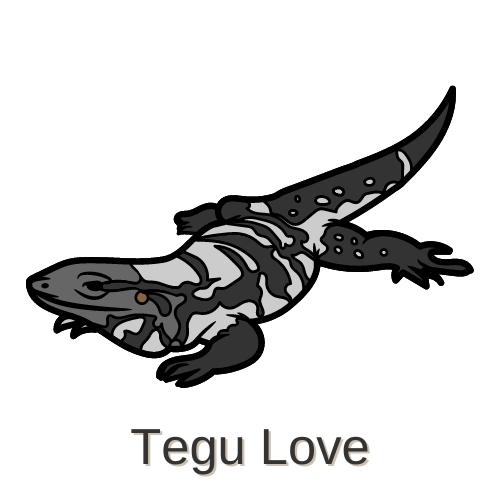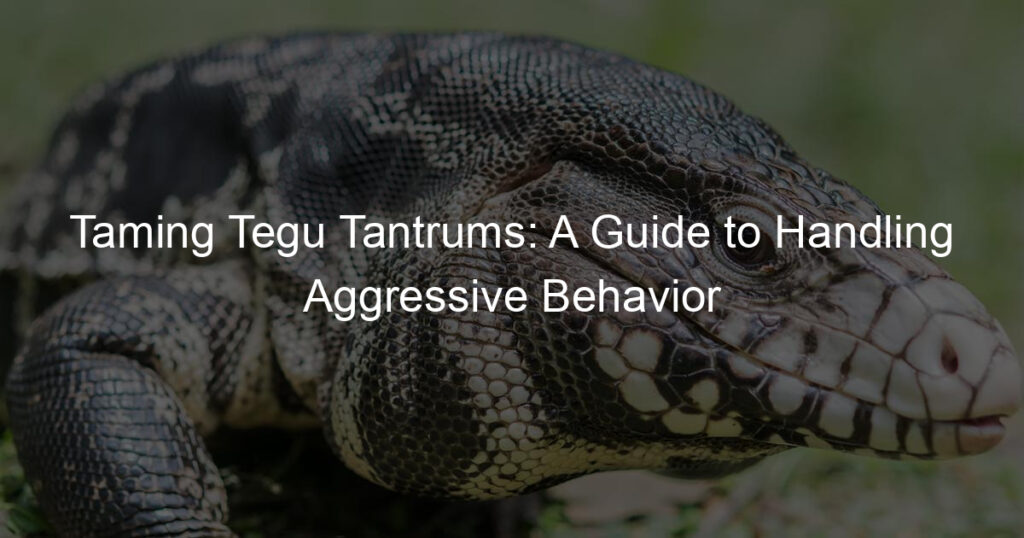
Introduction to Tegu Behavior
When it comes to understanding the behavior of Tegus, a popular type of reptile pet, there’s a lot to learn. These fascinating creatures have unique behaviors that set them apart from other reptiles. In this section, we will delve into the world of Tegu behavior, helping you understand what’s normal and what might be a sign of a problem.
-
Understanding Tegu Behavior
Tegus are known for their intelligence and curiosity. They are active creatures that enjoy exploring their environment. They are also known to be quite sociable, often seeking interaction with their human caretakers. Tegus communicate through a variety of behaviors such as body postures, tail movements, and vocalizations. For instance, a relaxed Tegu may lie flat with its limbs spread out, while an agitated one may puff up its body and hiss.
It’s important to remember that each Tegu is an individual with its own personality. Some may be more outgoing, while others may be more reserved. Understanding your Tegu’s unique behavior patterns can help you provide the best care for your pet.
-
Common Tegu Behavior Problems
While Tegus are generally well-behaved pets, they can sometimes exhibit behavior problems. These can range from aggression to refusal to eat. Aggression in Tegus can be caused by a variety of factors, including fear, stress, or territoriality. If your Tegu is showing signs of aggression, it’s important to identify the cause and address it promptly.
Another common behavior problem in Tegus is refusal to eat. This can be due to illness, stress, or a poor diet. If your Tegu is refusing to eat, it’s crucial to consult with a vet to rule out any underlying health issues.
Remember, understanding and addressing your Tegu’s behavior problems is key to ensuring their health and happiness.
In the following sections, we will delve deeper into identifying and handling aggressive Tegu behavior, taming Tegu tantrums, and understanding Tegu temperament. We will also share some case studies on aggressive reptile behavior, providing practical examples and insights. Stay tuned as we continue our journey into the fascinating world of Tegu behavior.
Identifying Aggressive Tegu Behavior
Understanding the behavior of your tegu is crucial for maintaining a healthy and happy pet. Aggression in tegus can be a sign of stress, fear, or illness. It’s important to know how to identify and manage this behavior to ensure the well-being of your tegu.
-
- Signs of Aggression in Tegus
Tegus are generally calm creatures, but they can display signs of aggression when they feel threatened or uncomfortable. Here are some signs to look out for:
-
-
- Hissing: This is a clear sign of discomfort or fear. If your tegu is hissing, it’s best to give it some space.
- Open-mouthed threat: If a tegu feels threatened, it may open its mouth wide as a warning sign.
- Whip-like tail movements: Tegus may use their tails to express discomfort or aggression.
- Scratching or biting: These are serious signs of aggression. If your tegu is scratching or biting, it’s important to seek professional help.
- Causes of Aggressive Tegu Behavior
-
There are several factors that can cause a tegu to behave aggressively. Some of the most common causes include:
-
- Stress: Tegus can become stressed due to changes in their environment, such as a new enclosure or the introduction of another pet.
- Fear: Tegus may act aggressively out of fear. This can be caused by a perceived threat, such as a larger animal or a sudden movement.
- Illness: If a tegu is feeling unwell, it may become more aggressive. Regular health checks are important to ensure your tegu is in good health.
- Mating season: Male tegus can become more aggressive during mating season. This is a natural behavior, but it’s important to monitor your tegu during this time to ensure it doesn’t become overly aggressive.
Understanding and identifying aggressive behavior in tegus is the first step towards managing it. In the following sections, we will explore how to handle an aggressive tegu and how to tame tegu tantrums.
Handling Aggressive Tegu
When it comes to managing the behavior of your Tegu, it’s crucial to understand that prevention is always better than cure. By taking certain preventive measures, you can significantly reduce the chances of your Tegu becoming aggressive.
Preventive Measures
There are two key areas to focus on when it comes to preventing aggressive behavior in Tegus: their habitat and their diet.
-
- Proper Tegu Habitats
Providing a suitable habitat for your Tegu is the first step towards preventing aggressive behavior. Tegus are creatures of habit and they thrive in environments that mimic their natural habitats. This means a large, secure enclosure with plenty of space to roam, hide, and bask. The temperature should be carefully regulated, with a basking area at one end and a cooler area at the other. Humidity levels should also be maintained at an appropriate level to keep your Tegu comfortable and healthy.
-
- Appropriate Tegu Diet
Just like humans, Tegus can become irritable when they’re hungry or not getting the right nutrients. A balanced diet is crucial for their overall health and behavior. Tegus are omnivores, which means they eat both plants and meat. Their diet should include a variety of fruits, vegetables, and high-quality proteins. Regular feeding, according to a schedule that suits your Tegu’s age and size, can also help prevent aggressive behavior.
In conclusion, providing a proper habitat and a balanced diet are two key preventive measures you can take to avoid aggressive behavior in your Tegu. Remember, a happy and healthy Tegu is less likely to exhibit aggression.
Handling Aggressive Tegu
Dealing with Tegu Aggression
When it comes to dealing with Tegu aggression, it’s crucial to understand the best practices and techniques. Here, we will discuss two key strategies: safe handling techniques and seeking professional assistance.
-
- Safe Handling Techniques
Handling a Tegu requires a gentle and confident approach. When a Tegu shows signs of aggression, it’s important to remain calm and avoid sudden movements. Here are some safe handling techniques:
-
-
- Use Protective Gear: Always wear gloves and long sleeves to protect your skin from potential bites or scratches.
- Approach Slowly: Move slowly and calmly towards your Tegu. Quick movements can startle them and trigger aggressive behavior.
- Support Their Body: When lifting a Tegu, always support their entire body. This helps them feel secure and reduces stress.
- Professional Assistance
-
If your Tegu continues to show signs of aggression despite your best efforts, it may be time to seek professional assistance. Reptile behaviorists and experienced Tegu handlers can provide valuable insights and techniques to help manage your pet’s aggression. Remember, it’s always better to seek help than risk injury to yourself or your Tegu.
Dealing with Tegu aggression can be challenging, but with patience, understanding, and the right techniques, it’s possible to manage and even reduce aggressive behavior. Always prioritize safety and don’t hesitate to seek professional help if needed.
Taming Tegu Tantrums
When it comes to taming Tegu tantrums, two key factors come into play: effective training techniques and consistency in training. Let’s delve into these aspects to understand how they can help in managing Tegu behavior.
-
Effective Training Techniques
Training your Tegu effectively is the first step towards taming its tantrums. Here are some techniques that have proven successful:
- Positive Reinforcement: Rewarding your Tegu for good behavior can encourage it to act more calmly. This could be in the form of treats, praise, or extra playtime.
- Regular Handling: Regular, gentle handling can help your Tegu become more comfortable with human contact, reducing its likelihood of acting out.
- Environmental Enrichment: Providing a stimulating environment for your Tegu can help keep it mentally engaged and less likely to display aggressive behavior.
-
Importance of Consistency in Training
Consistency is key in any form of training, and Tegus are no exception. Here’s why:
- Establishes Routine: Tegus, like many animals, thrive on routine. Consistent training helps establish a predictable pattern of behavior, which can reduce anxiety and tantrums.
- Reinforces Learning: Consistent training helps reinforce what your Tegu has learned, making it more likely to remember and follow the desired behaviors.
- Builds Trust: When you consistently respond to your Tegu’s behavior in the same way, it learns to trust you, which can significantly reduce aggressive behavior.
In conclusion, taming Tegu tantrums is a process that requires effective training techniques and consistency. With patience and persistence, you can help your Tegu become a calm and friendly pet.
Tegu Behavior Management
Managing the behavior of your Tegu is a crucial aspect of pet ownership. It’s not just about ensuring the safety of yourself and others, but also about ensuring the well-being of your Tegu. Let’s explore some long-term strategies for managing Tegu behavior.
Long-Term Strategies
Long-term strategies are all about consistency and patience. It’s about building a relationship with your Tegu and creating an environment that is conducive to their well-being. Here are two key strategies:
-
- Establishing Trust with Your Tegu
Trust is the foundation of any relationship, and it’s no different with your Tegu. Building trust with your Tegu involves spending time with them, handling them gently, and responding to their needs. It’s about showing them that you are not a threat, but a friend. This process may take time, but it’s worth it. A Tegu that trusts you is less likely to display aggressive behavior.
-
- Consistent Routine and Environment
Tegus are creatures of habit. They thrive in environments that are stable and predictable. This means maintaining a consistent feeding schedule, keeping their habitat clean and comfortable, and minimizing sudden changes in their environment. A consistent routine and environment can help reduce stress in your Tegu, leading to less aggressive behavior.
Remember, managing Tegu behavior is not about controlling them, but about understanding them and creating an environment where they can thrive. With patience and consistency, you can build a strong and trusting relationship with your Tegu.
Dealing with Persistent Aggression
When it comes to managing the behavior of your Tegu, it’s essential to understand how to deal with persistent aggression. This can be a challenging task, but with the right approach and resources, you can navigate this issue effectively.
-
- When to Seek Professional Help
Recognizing when to seek professional help is crucial. If your Tegu’s aggression continues despite your best efforts, it might be time to consult a professional. Signs that professional help may be needed include:
-
-
- Your Tegu is consistently aggressive and shows no signs of calming down.
- The reptile’s aggression is causing harm to itself or others.
- You feel overwhelmed or unsure about how to handle the situation.
-
Remember, there’s no shame in seeking help. Professionals have the knowledge and experience to provide the best care for your Tegu.
-
- Resources for Tegu Owners
There are numerous resources available to help Tegu owners manage their pet’s behavior. These include:
| Resource | Description |
|---|---|
| Books on Tegu Care | These provide comprehensive information on Tegu behavior and how to manage it. |
| Online Forums | These platforms allow you to connect with other Tegu owners and share experiences and advice. |
| Professional Consultations | These sessions provide personalized advice and strategies for managing your Tegu’s behavior. |
Utilizing these resources can provide you with the knowledge and support you need to manage your Tegu’s aggression effectively.
In conclusion, dealing with persistent aggression in Tegus can be challenging, but it’s not impossible. Recognize when to seek professional help and make use of the resources available to you. With patience and consistency, you can help your Tegu become a more calm and content companion.
Understanding Tegu Temperament
When it comes to understanding the temperament of a Tegu, it’s important to remember that each one is unique. However, there are common traits and behaviors that can give us a general idea of what to expect. Let’s delve deeper into the factors that influence Tegu temperament and clear up some common misconceptions.
-
- Factors Influencing Tegu Temperament
Several factors can influence a Tegu’s temperament. These include:
-
-
- Environment: Tegus are sensitive to their surroundings. A clean, spacious, and stimulating environment can lead to a happier, more content Tegu.
- Diet: A balanced and nutritious diet is crucial for a Tegu’s overall health and mood. A malnourished Tegu may exhibit aggressive or lethargic behavior.
- Handling: Regular, gentle handling can help a Tegu become more comfortable with human interaction, leading to a calmer temperament.
- Common Misconceptions about Tegu Temperament
-
There are several misconceptions about Tegu temperament. Let’s debunk a few:
-
- Tegus are always aggressive: This is not true. While Tegus can display aggressive behavior, with proper care and handling, they can also be quite docile and friendly.
- Tegus are solitary animals: While Tegus are not social in the same way dogs or humans are, they can form bonds with their owners and enjoy interaction.
- All Tegus are the same: Just like humans, each Tegu has its own personality. Some may be more active, while others are more laid back. It’s important to spend time with your Tegu to understand its unique temperament.
Understanding a Tegu’s temperament is key to ensuring they live a happy and healthy life. By debunking misconceptions and understanding the factors that influence their behavior, we can better care for these fascinating creatures.
Case Studies on Aggressive Reptile Behavior
Let’s take a closer look at some real-life examples of aggressive Tegu behavior. These case studies will help us understand the triggers and responses of Tegus, and how to manage them effectively.
-
Tegu Behavior Case Study 1
In our first case study, we will discuss a Tegu named Max. Max was known for his aggressive behavior, especially during feeding time. He would hiss, whip his tail, and even attempt to bite his owner.
The owner decided to change Max’s environment, providing him with a larger enclosure and more hiding spots. He also started using a feeding tong to create a safe distance during feeding time. Over time, Max’s aggressive behavior decreased significantly.
Before Intervention After Intervention Aggressive during feeding Less aggressive during feeding No hiding spots Multiple hiding spots Small enclosure Larger enclosure -
Tegu Behavior Case Study 2
Our second case study involves a Tegu named Bella. Bella was often aggressive when being handled. She would puff up her body, hiss, and try to run away.
Bella’s owner decided to change the way he approached her. Instead of picking her up directly, he started to let Bella come to him. He would sit near her enclosure and wait for Bella to approach. This method helped Bella feel less threatened and reduced her aggressive behavior.
Before Intervention After Intervention Aggressive when handled Less aggressive when approached Owner approached Bella Bella approached owner
These case studies highlight the importance of understanding Tegu behavior and adjusting our actions accordingly. With patience and the right approach, we can manage and even reduce aggressive behavior in Tegus.
Conclusion: Taming Tegu Tantrums
In this article, we have explored the behavior of Tegus, identified signs of aggression, and discussed effective ways to manage and tame their tantrums. The journey of understanding and managing Tegu behavior can be challenging, but with patience, knowledge, and the right approach, it is entirely possible to create a peaceful coexistence.
-
- Key Takeaways on Handling Aggressive Tegu
Understanding Tegu behavior is the first step towards managing their aggression. Tegus are not naturally aggressive creatures, but their behavior can be influenced by factors like their environment, health, and handling. Regular interaction, providing a suitable habitat, and monitoring their health can significantly reduce aggressive behavior. Remember, a calm and patient approach is key when dealing with Tegus.
-
- Final Thoughts on Tegu Behavior Management
Managing Tegu behavior is not a one-time task but a continuous process. It requires consistent effort, understanding, and a lot of patience. It’s important to remember that every Tegu is unique and what works for one may not work for another. Therefore, it’s crucial to observe your Tegu’s behavior closely and tailor your approach accordingly. With time and patience, you can successfully manage and even prevent Tegu tantrums.
In conclusion, Tegus are fascinating creatures with unique behaviors. While they can display aggression, it’s important to remember that this is usually a response to their environment or handling. By understanding their behavior and implementing effective management strategies, you can enjoy a peaceful and rewarding relationship with your Tegu.














